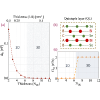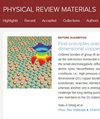Tuning the quantum phase transition of an ultrathin magnetic topological insulator
IF 3.4
3区 材料科学
Q2 MATERIALS SCIENCE, MULTIDISCIPLINARY
引用次数: 0
Abstract
We explore the effect of thickness, magnetization direction, strain, and gating on the topological quantum phase transition of a thin-film magnetic topological insulator. Reducing the film thickness to the ultrathin regime couples the edge states on the two surfaces, opening a gap known as the hybridization gap, and causing a phase transition from a topological insulator to a normal insulator (NI). An out-of-plane/in-plane magnetization of size proportional to the hybridization gap triggers a phase transition from a normal insulator state to a quantum anomalous Hall (QAH)/semimetal state. A magnetization tilt by angle from the out-of-plane axis influences the topological phase transition in a way that for sufficiently large , no phase transition from NI to QAH can be observed regardless of the sample thickness or magnetization, and for close to the system transits to a semimetal phase. Furthermore, we demonstrate that compressive/tensile strain can be used to decrease/increase the magnetization threshold for the topological phase transition. Finally, we reveal the effect of a vertical potential acting on the film, be it due to the substrate or applied gating, which breaks inversion symmetry and raises the magnetization threshold for the transition from NI to QAH state.

调节超薄磁性拓扑绝缘体的量子相变
我们探索了厚度、磁化方向、应变和门控对薄膜磁性拓扑绝缘体拓扑量子相变的影响。将薄膜厚度减小到超薄状态会耦合两个表面上的边缘态,打开一个被称为杂化间隙的缺口,导致从拓扑绝缘体到正常绝缘体(NI)的相变。与杂化间隙大小成正比的平面外/平面内磁化会引发从正常绝缘体态到量子反常霍尔(QAH)/半金属态的相变。与平面外轴线成θ角的磁化倾斜会影响拓扑相变,在θ足够大的情况下,无论样品厚度或磁化程度如何,都无法观察到从NI到QAH的相变,而当θ接近π/2时,系统会过渡到半金属相。此外,我们还证明了压缩/拉伸应变可用于降低/提高拓扑相变的磁化阈值。最后,我们揭示了作用在薄膜上的垂直电势(无论是由于基底还是外加门控)的影响,它打破了反转对称性,提高了从 NI 到 QAH 状态转变的磁化阈值。
本文章由计算机程序翻译,如有差异,请以英文原文为准。
求助全文
约1分钟内获得全文
求助全文
来源期刊

Physical Review Materials
Physics and Astronomy-Physics and Astronomy (miscellaneous)
CiteScore
5.80
自引率
5.90%
发文量
611
期刊介绍:
Physical Review Materials is a new broad-scope international journal for the multidisciplinary community engaged in research on materials. It is intended to fill a gap in the family of existing Physical Review journals that publish materials research. This field has grown rapidly in recent years and is increasingly being carried out in a way that transcends conventional subject boundaries. The journal was created to provide a common publication and reference source to the expanding community of physicists, materials scientists, chemists, engineers, and researchers in related disciplines that carry out high-quality original research in materials. It will share the same commitment to the high quality expected of all APS publications.
 求助内容:
求助内容: 应助结果提醒方式:
应助结果提醒方式:


